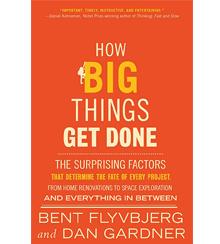Why do large projects go over budget?
A study of more than 100 years of infrastructure megaprojects reveals a consistent pattern of challenges at their core.

How Big Things Get Done: The Surprising Factors That Determine the Fate of Every Project, from Home Renovations to Space Exploration and Everything In Between
by Bent Flyvbjerg and Dan Gardner, Currency, 2023
“There are three kinds of lies,” the old saying goes. “Lies, damned lies, and cost projections for big projects.”
Yes, yes, the third item in the old saw is supposed to be statistics. But you, too, might feel the substitution appropriate if you’d just read How Big Things Get Done, an indispensable if perhaps unduly optimistic response to the tendency of modern projects, like California’s US$9 billion high-speed train project, to go, um, off the rails.
Nuclear power construction and IT projects also tend to go disastrously and exorbitantly wrong. But these are just three of the worst kinds of megaprojects, a cursed category defined by the authors, Bent Flyvbjerg and Dan Gardner, as projects exceeding US$1 billion in costs. These ventures run so horribly and consistently over budget and beyond schedule that their risks should give pause to any business leader, politician, or organization considering one.
Flyvbjerg, an Oxford expert on the mega-troubles of megaprojects, and Gardner, a journalist who helped Flyvbjerg convey in crisp English prose what’s he’s learned about the subject during years of study and consulting, have written one of the most important and readable business books you are ever likely to encounter.
The book’s central message is twofold. First, for a variety of political and psychological reasons, humankind nowadays is really bad at giant undertakings. Though some kinds of projects are particularly likely to go bad, and some places seem to have a harder time building them than do others, the problem is, in fact, global, and it affects digital infrastructure as well as bridges, tunnels, subways, airports, and buildings. Second, improvement in this difficult realm is imperative. Squandering a fortune on complex initiatives that in many cases fail to deliver promised benefits is bad for human welfare, to say nothing of the careers of those who lead them. Addressing climate change will require that we find a way to carry out large-scale projects at reasonable prices with good results.
It won’t be easy. Flyvbjerg has assembled what is likely the world’s premier database on the subject, containing more than 16,000 projects from 20-plus different fields in 136 countries going back to 1910, from Olympic games to nuclear power plants—even NASA’s James Webb Space Telescope, which went 450% over budget. He finds that a staggering 91.5% of projects go over budget, over schedule, or both. Worse, less than 1% of projects are completed on time and on schedule, and actually deliver the benefits promised.
A staggering 91.5% of projects go over budget, over schedule, or both.
“It’s hard to overstate how bad that record is,” the authors write. “For anyone contemplating a big project, it is truly depressing. But as grim as those numbers are, they don’t tell the full truth—which is much worse.”
That’s because, though the mean cost overrun is 62%, the distribution of megaproject overruns has a fat tail, suggesting catastrophic risks. “To illustrate,” the authors continue, “18% of IT projects have cost overruns above 50% in real terms. And for those projects the average overrun is 447%!”
What is to be done? Flyvbjerg and Gardner offer several key principles to avoid megaproject disasters. These takeaways can be put to work on projects far below the scale of, say, Boston’s infamous Big Dig (completed a decade later than originally planned) but still big enough to sink an executive if not an entire business. They even make sense for a home renovation.
Know where you’re going. The authors’ motto is “think slow, act fast.” Start by examining your goal. Your aim is not really to build a train, for instance. It’s to get people or goods from point A to point B. And so you have to ask if a train is even the best way to accomplish this goal.
Plan with ferocious rigor. Try out different versions of a project, availing yourself of technologies such as computer-aided design. Understand that almost no project is truly unique—and if it is, then you’re in trouble. Find analogous projects and learn from them—including by talking to those who were involved. Hire only people thoroughly experienced at your particular kind of project, no matter where they are from—and that goes double for the person in charge, who must assemble a reliable and committed team. (The Olympics move from place to place, thereby squandering the learning so painfully acquired by predecessors.)
Follow the Lego principle. Break big undertakings into small, repeatable ones. Each iteration will bring efficiency gains. The success story of New York’s Empire State Building, which took just more than a year to build from start to finish in 1930–31, is fascinating on this score. So is the contrary tale of Sydney’s famous Opera House, opened in 1973, which ruined its architect’s career and wasn’t even well suited for opera. (At least a great building came out of it.)
Beware the gravitational pull of sunk costs. It’s common to adopt wildly optimistic cost projections for big projects in order to overcome opposition; once things get going, everyone will feel that they’re in too deep to turn back. “Start digging a hole and make it so big, there’s no alternative to coming up with the money to fill it in,” wrote former San Francisco mayor Willie Brown, who oversaw the city’s Transbay Terminal project. This approach leads to poor execution, massive overspending, scandal, and a loss of credibility. Better to face costs honestly up front and plan with exquisite care before doing anything drastic. The longer the building portion takes, the more time for something unexpectedly bad to happen.
Given the size and scope of the projects in question, it’s also important to acknowledge that there are lots of ways to measure return on investment to individuals and communities. In a world where things are always late and cost more than promised, bringing in projects on time and at cost will yield even more significant returns—in capital and in reputation.
Author profile:
- Daniel Akst is a business writer, author, and novelist based in New York’s Hudson Valley. His books include Temptation: Finding Self-Control in an Age of Excess.


